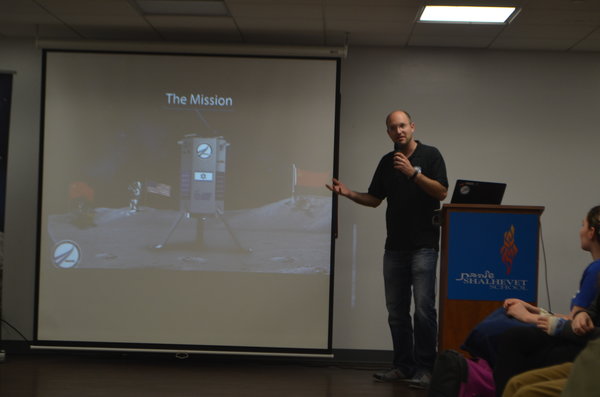SpaceIL is attempting to put an Israeli rover on the moon

LUNAR: Yariv Bash presents his Tel Aviv-based company to students in a special assembly Jan. 29. His project, SpaceIL, aims to send a rover to the moon as part of Google’s Lunar X Prize competition.
February 16, 2014
By Jonah Gill, Outside News Editor
United States, Russia, China: one would probably say these are the three biggest countries in the world. Or the strongest. Or the wealthiest.
Another thing these countries have in common is that they all have sent a spacecraft, manned or unmanned, to the moon. And as Shalhevet students learned in an assembly Jan. 29, SpaceIL, a company based out of Tel Aviv is attempting to add Israel to that list — and without government sponsorship.
A program arranged by Bnai Akiva brought in Yariv Bash, one of the co-founders of SpaceIL, to the Beit Midrash, where he described his company’s current work to students and answered questions about his goal of reaching the moon.
As Mr. Bash explained, SpaceIL is one of 18 teams left in the Google Lunar X Prize, or Moon 2.0, competition. The contest, which was launched seven years ago, challenges privately funded teams to land a robot on the surface of the moon and travel 500 meters on the ground. The first place prize is $20 million and the runner-up will be awarded $5 million.
During the assembly, Mr. Bash said his company had been born the modern way — on social media.
“I posted on Facebook about wanting to join the challenge,” he said, and received a reply from Kfir Damarai. “He said if I was in, so was he. That’s how SpaceIL was started.”
SpaceIL he said, turned out to be the only not-for-profit organization competing, relying solely on donations, unlike other entries in the competition which rely on investments promising a return. All of the other competitors are for-profit enterprises.
Mr. Bash said this made paying for the launch one of their main hardships in putting a rover on the moon.
“We are a non-profit company,” Mr. Bash said, “and we are serious and a front runner in this competition, but the average launch costs $9 million, and raising that kind of money might be our biggest challenge yet.”
Nevertheless, Mr. Bash said that he’s optimistic and that SpaceIL is a front-runner in the competition today.
“We and two other companies from California are by far the closest in putting our robot on the moon, and most likely the winner will be one of us,” he said.
Students seemed to enjoy the presentation. Sophomore Will Bernstein, who attended a program at the Technion in Haifa last summer, said it made him proud.
“I have an obsession with anything involving space,” said Will, who is a member of the optional CIJE Engineering course for freshman and sophomores. “So when we have an assembly involving my two favorite things, Israel and Space, I was absolutely amazed and felt so much pride.”
And while three years from now, today’s Shalhevet students may not remember the assembly, there will be something of it that will still exist — because at the end of the assembly each grade posed for a picture with Bash and Damarai. The photos will be put on a microchip and the microchip will be put on the rover when it takes off to the moon.
“The possibility of my picture being on the moon is very cool,” said junior Margo Feuer. “But what I think is even cooler is that my picture, stored on an Isreali-made microchip, is part of an Israeli team’s space campaign, which is an awesome example of Israeli scientific achievement.”












